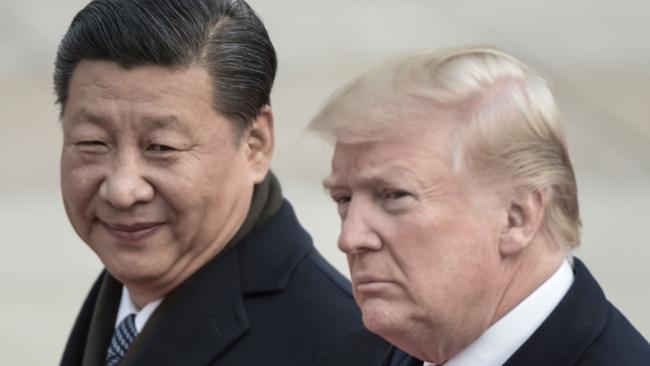
Both the US and Chinese presidents know that their power — and in the case of Trump, a second term in the White House — depends on economic prosperity. Trump was elected to power partly on the basis of either striking a better trade deal with China or imposing high tariffs.
He has never wavered from that position and his weekend tweets were in part a reminder to Xi of the US base position.
Xi is a long-term player and he wants a deal that gives Trump enough to claim victory but gives China wriggle room to pursue its goals into the future. Trump, however, is not allowed a third term, thanks to the US constitution’s 22nd amendment.
To understand this week’s sharp market fluctuations, we need to go back to the final quarter of 2018.
During that period, the combination of US tariff increases and other measures, plus Xi’s financial clamps to take the heat out of the Chinese economy, were having a severe impact on the Chinese business activity, which was reflected in the sharemarket. The Shanghai index fell to a four-year low.
Xi could see danger and turned the stimulation pumps on again.
Over in the US, Trump could sense victory and we saw an increasingly confident US president. And he was right. Xi’s people changed their stance and admitted China had stolen technology. It was a dramatic moment. The trade negotiations gained impetus.
The US economy continued to perform well boosted, by tax cuts. But that better performance triggered an expectation of more interest rate hikes. Suddenly Trump saw the Federal Reserve as the enemy within and he broke all conventions by telling the Fed in no uncertain terms not to raise rates. The Federal Reserve duly obeyed the president.
A trade deal started to take shape and I set out the broad form of the deal in February.
Under such a deal, China will significantly increase imports of US goods and services, reduce tariff and non-tariff barriers on imports from the US and open its domestic economy to more US and foreign companies.
And watch out Australia, because China’s greater imports from the US will focus on agricultural and energy products.
China agreed to commit to enhance intellectual property protection through amendment of Chinese patent law, a better enforcement mechanism and a reduction in higher tariffs on imports from the US on goods such as cars.
The list of Chinese concessions went on. China would enforce the ban on exports of the drug fentanyl to the US, expedite the approval of US companies entering into sectors including financial services, agriculture and car manufacturing in China; ban forced technology transfers, open domestic markets further, reduce subsidies and excess capacities, and embark on other structural reforms.
Did Xi go too far? Did he preserve long-term wriggle room? These are questions that are being debated in China.
In China meanwhile, the combination of a likely trade deal and Xi’s stimulation turned the economy around. The markets loved it and the Shanghai index soared.
The US economy also gathered more momentum with employment and wages in the March quarter rising further. Both Trump and Xi had stimulated their economies and looked set to do a trade deal.
But the Chinese outlook in May 2019 is far better than the last quarter of 2018.
Xi and his people know that Trump needs a strong Wall Street to have any chance of re-election.
Maybe China can do a better deal. Xi concluded he had gone too far and decided to backtrack and to test Trump’s resolve. In the wards of Trump’s top trade negotiator Robert Lighthizer: “We felt we were on track to get somewhere. Over the course of last week we have seen an erosion of commitments by China. That, in our view, is unacceptable,”
The Trump administration now plans to increase duties on Chinese imports at 12.01am on Friday 10 May 10.
However the trade talks will continue and a Chinese delegation will visit Washington on Thursday and Friday. They will be tense discussions.
Meanwhile, the US economy has Trump bursting with confidence he is in no mood for major concessions. Trump uses tweets to destabilise opponents. And so there could be no better day to send a tough message to Xi than the day of the Kentucky Derby.
Trump’s confidence then multiplied with the sharp fall in the Shanghai index.
American shares also opened the week with a big fall. But then the sheer momentum of the US economy and the fact that the Federal Reserve is not raising rates kindled buying pressures and Wall Street recovered most of the early Monday losses. The Lighthizer statement will provide another test.
It’s not how previous presidents have acted, but US markets are now much more accepting of Trump’s tweets.
The danger is that Trump may become overconfident and overplay his hand.
Xi actually respects Trump because he knows where the US is coming from. China has been surprised that the US took so long to act. While Xi and his people will be looking for escape clauses, the markets are telling both Xi and Trump that neither side can afford to walk away — especially China.





Join me today to explore the mind games and strategies of two masters of the art of negotiation — Donald Trump and Xi Jinping. Their manoeuvres have provided the fuel for this week’s huge fluctuations in stock markets - including a big lift in the stakes after Wall Street closed on Monday night.